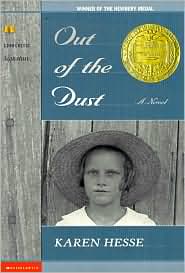
BIBLIOGRAPHY
Hesse, Karen. 1997. OUT OF THE DUST. New York: Scholastic. ISBN 0590371258
PLOT SUMMARY
This is the story of a young girl growing up in Oklahoma during the dust bowl days of the Great Depression. She and her family struggle not only financially but also emotionally as the relentless dust takes its toll. After Billie Jo’s mother and unborn brother die in an accident that both Billie Jo and her father have a hand in, she tries unsuccessfully to connect with her distant father. The accident left Billie Jo’s hands badly burned and she can longer take comfort in the one thing that brought her joy, “playing fierce piano.” Billie Jo leaves home thinking she can escape the dust, but soon realizes that
Getting awayAfter forgiving herself and rebuilding her relationship with her father, Bille Jo learns at last that
it wasn’t any better.
Just different.
And lonely.
Lonelier than the wind.
Emptier than the sky.
More silent than the
dust,
piled in drifts between me
And my
father.
What I am,CRITICAL ANALYSIS
I am because of the dust.
And what I am is good enough.
Even for me.
Written in verse, OUT OF THE DUST, chronicles the stark, bereft life of Billie Jo. The story takes place between January 1934 and December 1935 and each poem reads like an entry in a journal. Billie Jo’s innermost thoughts and feelings are on each page as Hesse uses free verse to tell her story.
Hesse’s language is as sparse as life in the 1930’s dust bowl of the Oklahoma panhandle. She captures the desolation and despair of the time in history but also the determination of the people to not give in and give up. In a format where every word counts, Hesse makes the most of her word choices. In the poem “Driving the Cows”, in just a few lines, Hesse paints a landscape sinking under the weight of the dust.
Dust
piles up like snow
across the prairie,
dunes leaning against
fences,
mountains of dust pushing over barns.
On every page, Hesse’s choice of words brings vivid images to mind. The reader experiences a dust storm through her vivid imagery: “winds came, / bringing a red dust / like prairie fire, / hot and peppery, searing the inside of my nose.”
In the “After Words”, Hesse notes that OUT OF THE DUST came out of research for a picture book, COME ON RAIN. According to Hesse, she was so fascinated by the period, that the picture book was put on hold, and she began writing OUT OF THE DUST. The “After Words” also includes a question and answer session with the author and describes historical efforts to visually record the depression and dust bowl era.
OUT OF THE DUST provides a fictional look at a time of hardship in America. This novel is more suitable for middle school students, but older students as well as adults will be drawn into Billie Jo’s world.
REVIEW EXCERPT(S)
BOOKLIST starred review: “The story is bleak, but Hesse’s writing transcends the gloom and transforms it into a powerfully compelling tale of a girl with enormous strength, courage, and love.”
SCHOOL LIBRARY JOURNAL: “A triumphant story, eloquently told through prose- poetry.
PUBLISHER’S WEEKLY starred review: “This intimate novel, written in stanza form, poetically conveys the heat, dust, and wind of Oklahoma. With each meticulously arranged entry Hesse paints a vivid picture of her heroine’s emotions.”
CONNECTIONS
This book can be used to supplement history lessons about Oklahoma, the dust bowl and the Great Depression.
Other fiction books about the Great Depression include:
Craven, Tracy Leininger. KATHLEEN’S UNFORGETTABLE WINTER. ISBN 9781928749264
Dearan, Patrick. WHEN THE SKY RAINED DUST. ISBN 9781571688309
Other Newbery Award winner books:
Blos, Joan W. A GATHERING OF DAYS : A NEW ENGLAND GIRL'S JOURNAL, 1830-32 : A NOVEL. ISBN 068971419X
Cleary, Beverly. DEAR MR. HENSHAW. ISBN 0380709589
Curtis, Christopher Paul. Bud, not Buddy. ISBN 0440413281
No comments:
Post a Comment